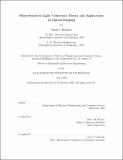| dc.contributor.author | Erkmen, Baris I. | |
| dc.date.accessioned | 2008-05-14T15:48:36Z | |
| dc.date.available | 2008-05-14T15:48:36Z | |
| dc.date.issued | 2008-05-14T15:48:36Z | |
| dc.identifier.uri | http://hdl.handle.net/1721.1/41536 | |
| dc.description | Thesis Supervisor: Jeffrey H. Shapiro
Title: Julius A. Stratton Professor | en |
| dc.description.abstract | Spontaneous parametric downconversion (SPDC) can produce pairs of entangled photons,
i.e., a stream of biphotons. SPDC has been utilized in a number of optical imaging applications,
such as optical coherence tomography, ghost imaging, holography and lithography, to
obtain performance that cannot be realized with standard optical sources. However, a debate
continues as to whether the improved imaging characteristics of such systems should be
attributed to the entanglement property of the photon pairs. This thesis sets out to unify—
and generalize—classical and quantum imaging within the framework of Gaussian-state
light fields, which encompasses thermal light—the source used in conventional imagers—
and biphoton-state light as special instances. Within this framework, we are able to provide
a complete understanding of the boundary between classical and quantum behavior in optical
coherence tomography (OCT), ghost imaging and two-photon imaging. Furthermore,
we show that almost all characteristics of biphoton-state imagers are due to phase-sensitive
cross correlations, and hence are obtainable with classical phase-sensitive sources. | en |
| dc.description.sponsorship | U. S. Army Research Office MURI Grant W911NF-05-
1-0197. | en |
| dc.language.iso | en_US | en |
| dc.relation.ispartofseries | Technical Report (Massachusetts Institute of Technology, Research Laboratory of Electronics); | en |
| dc.relation.ispartofseries | #722 | en |
| dc.title | Phase-Sensitive Light: Coherence Theory and Applications to Optical Imaging | en |
| dc.type | Technical Report | en |

